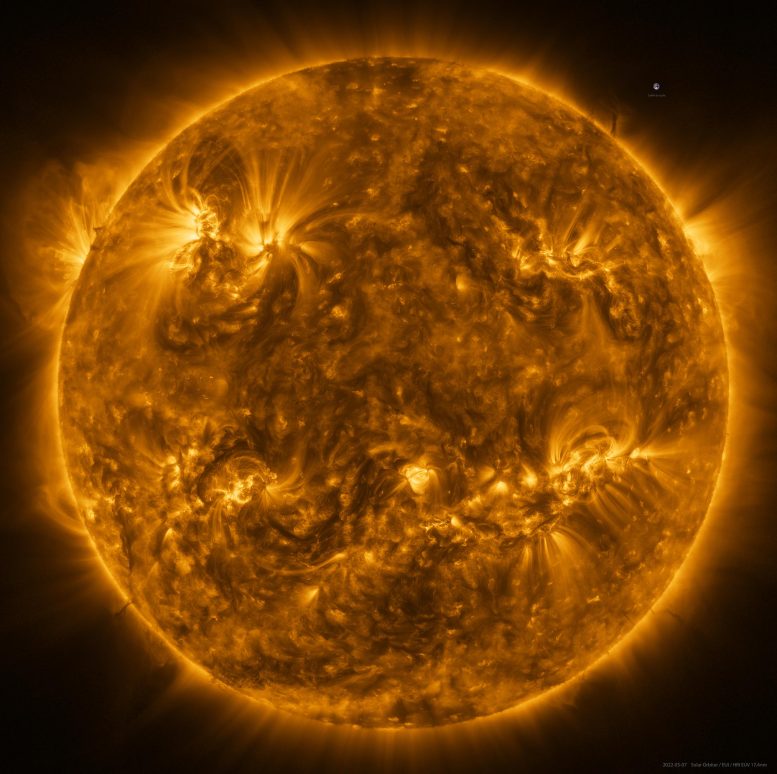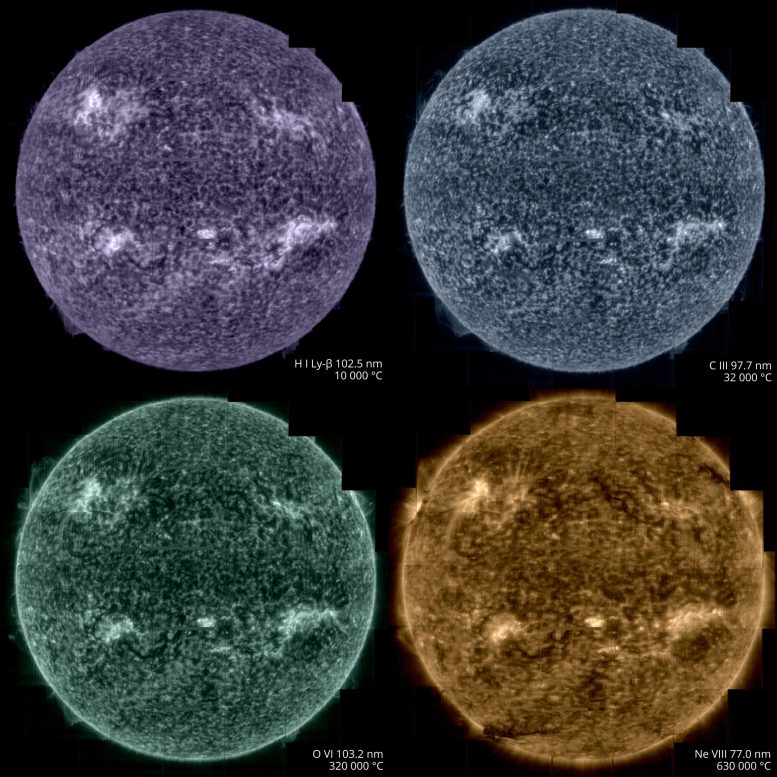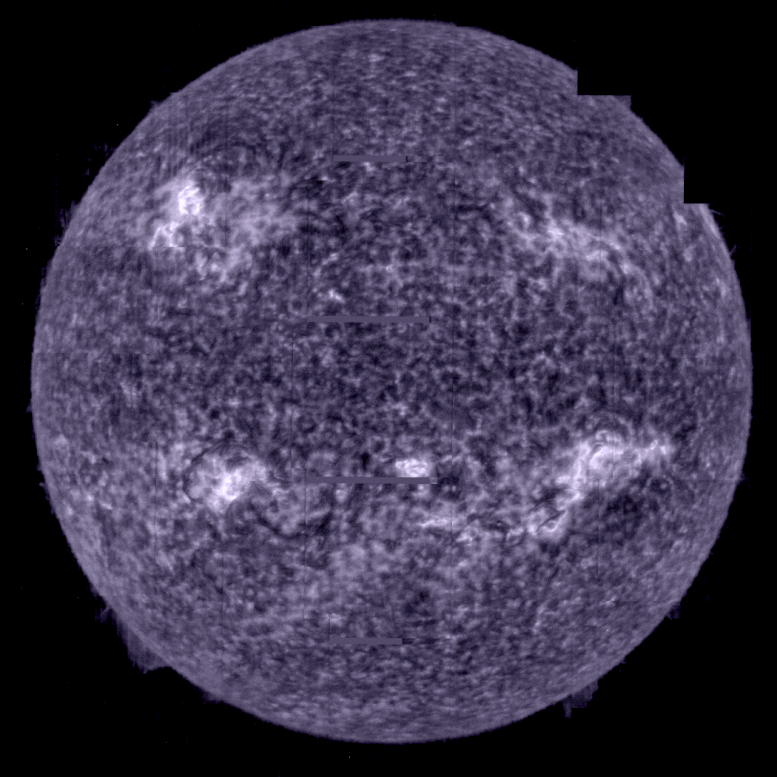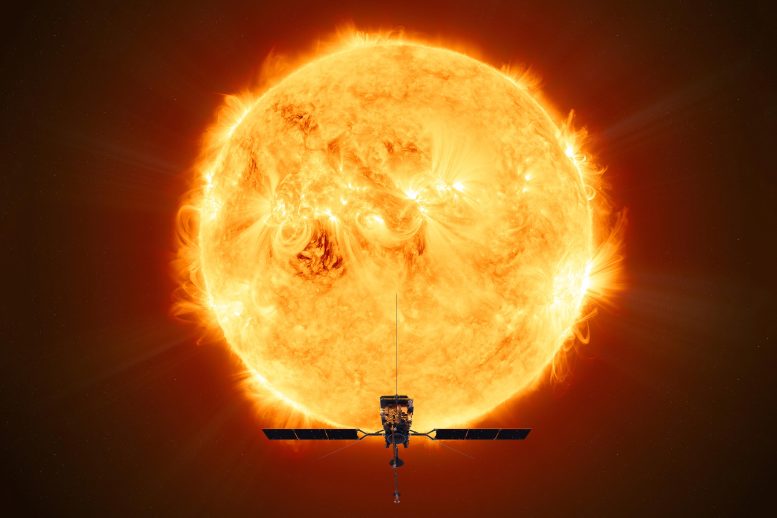
Animação do Solar Orbiter da Agência Espacial Europeia. Crédito: ESA / Medialab
As últimas imagens do Solar Orbiter mostram o sol pleno em detalhes sem precedentes. Foi tirada em 7 de março de 2022, quando a espaçonave transitava diretamente entre a Terra e o Sol.
Uma das imagens capturadas pelo Extreme Ultraviolet Imager (EUI) é a imagem de maior resolução do disco do Sol e da atmosfera externa, a coroa, já obtida.
Outra imagem obtida pelo instrumento Spectral Imaging of the Coronal Environment (SPICE) representa a primeira imagem completa do Sol em 50 anos e a melhor imagem obtida ao longo do comprimento de onda beta de Lyman da radiação ultravioleta emitida pelo gás hidrogênio.
As imagens foram tiradas quando o orbitador solar estava a cerca de 75 milhões de quilômetros de distância, a meio caminho entre o nosso mundo e sua estrela-mãe. O telescópio de alta resolução da EUI captura imagens com uma resolução espacial tão alta que, a essa distância próxima, é necessário um mosaico de 25 imagens individuais para cobrir todo o Sol. Tirada uma a uma, a imagem completa foi tirada em um período de mais de quatro horas, porque cada peça leva cerca de 10 minutos, incluindo o tempo que a espaçonave leva para apontar de uma parte para a outra.

O Sol visto pelo Solar Orbiter em luz ultravioleta extrema a uma distância de aproximadamente 75 milhões de km. A imagem é um mosaico de 25 imagens individuais tiradas em 7 de março de 2022 pelo Ultraviolet Imaging Instrument (EUI) High Resolution Telescope. Esta imagem foi tirada em um comprimento de onda de 17 nanômetros, na região ultravioleta extrema do espectro eletromagnético, revelando a atmosfera superior do sol, a coroa, que tem uma temperatura de cerca de um milhão de graus Celsius. Uma imagem da Terra da escala na posição das 2 horas também está incluída Crédito: ESA e NASA/Solar Orbiter/EUI Team; Processamento de dados: E. Kraaikamp (ROB)
No total, o imagem final Ele contém mais de 83 milhões de pixels em uma grade de 9148 x 9112 pixels. Para comparação, esta imagem tem uma resolução dez vezes melhor do que uma tela de TV 4K pode exibir.
EUI retrata o Sol em um comprimento de onda de 17 nanômetros, na região ultravioleta extrema do espectro eletromagnético. Isso revela a atmosfera superior do sol, a coroa, que tem uma temperatura de cerca de um milhão de graus[{” attribute=””>Celsius.

Solar Orbiter took images of the Sun on March 7, from a distance of roughly 75 million kilometres, using its Spectral Imaging of the Coronal Environment (SPICE) instrument. SPICE takes simultaneous “spectral images” at several different wavelengths of the extreme ultraviolet spectrum by scanning its spectrometer slit across a region on the Sun. The different wavelengths recorded correspond to different layers in the Sun’s lower atmosphere. Purple corresponds to hydrogen gas at a temperature of 10,000°C, blue to carbon at 32,000°C, green to oxygen at 320,000°C, yellow to neon at 630,000°C. Each full-Sun image is made up of a mosaic of 25 individual scans. It represents the best full Sun image taken at the Lyman beta wavelength of ultraviolet light that is emitted by hydrogen gas. Credit: ESA & NASA/Solar Orbiter/SPICE team; Data processing: G. Pelouze (IAS)
At the 2 o’clock (near the image of the Earth for scale) and 8 o’clock positions on the edges of the Sun, dark filaments can be seen projecting away from the surface. These ‘prominences’ are prone to erupt, throwing huge quantities of coronal gas into space and creating ‘space weather’ storms.
In addition to EUI, the SPICE instrument was also recording data during the crossing. These too needed to be pieced together as a mosaic.
SPICE is designed to trace the layers in the Sun’s atmosphere from the corona, down to a layer known as the chromosphere, getting closer to the surface. The instrument does this by looking at the different wavelengths of extreme ultraviolet light that come from different atoms.

Taking the Sun’s temperature. Credit: ESA & NASA/Solar Orbiter/SPICE team; Data processing: G. Pelouze (IAS)
In the SPICE sequence of images purple corresponds to hydrogen gas at a temperature of 10,000°C, blue to carbon at 32,000°C, green to oxygen at 320,000°C, yellow to neon at 630,000°C.
This will allow solar physicists to trace the extraordinarily powerful eruptions that take place in the corona down through the lower atmospheric layers. It will also allow them to study one of the most puzzling observations about the Sun: how the temperature is rising through the ascending atmospheric layers.
Usually the temperature drops as you move away from a hot object. But above the Sun, the corona reaches a million degrees Celsius whereas the surface is only about 5000°C. Investigating this mystery is one of the key scientific objectives of Solar Orbiter.
The images were taken on 7 March, precisely when Solar Orbiter crossed the Sun-Earth line, so the images can be compared with Earth-bound solar instruments and cross-calibrated. This will make it easier to compare results from different instruments and observatories in future.
On March 26, Solar Orbiter reaches another mission milestone: its first close perihelion. The spacecraft is now inside the orbit of Mercury, the inner planet, taking the highest resolution images of the Sun it can take. It is also recording data on the solar wind of particles that flows outwards from the Sun.
And this is just the start, over the coming years the spacecraft will repeatedly fly this close to the Sun. It will also gradually raise its orientation to view the Sun’s previously unobserved polar regions.
Solar Orbiter is a space mission of international collaboration between ESA and NASA.

“Especialista em comida. Nerd de álcool. Leitor extremo. Empreendedor. Fanático devoto de mídia social. Especialista em cerveja ávido. Introvertido. Pensador freelance.”

